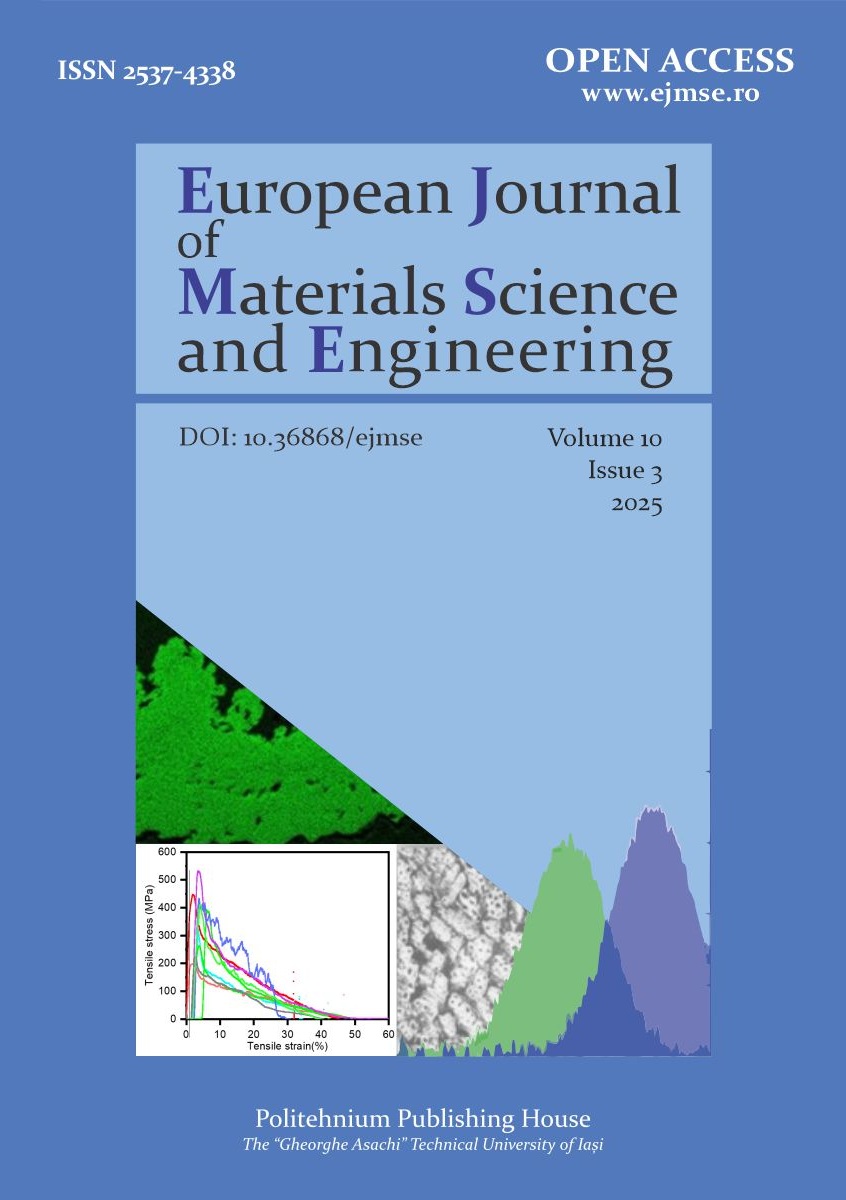SKIN TEMPERATURE AND MOISTURIZING EFFECTS OF FILMS WITH PHASE CHANGE MATERIALS, ERYTHRITOL, AND COCONUT OIL
European Journal of Materials Science and Engineering, Volume 10, Issue 3, 2025
PDF Full Article, DOI: 10.36868/ejmse.2025.10.03.195, pp. 195-206
Published: September 20, 2025
Byungmin PARK1,*
1 67, Yeongdong-daero 112-gil, Gangnam-gu, Seoul
* Corresponding author: mm5237613@gmail.com
Abstract
To explore ways to protect dogs’ paw pads from hot asphalt in the summer and snow removal chemicals in winter, a film was created by adding erythritol, a sugar alcohol that has a moisturizing effect and is a phase-changing material that undergoes an endothermic reaction when it changes from a solid to a liquid, and coconut oil, which is often used as a moisturizer, to a pullulan solution. When 15g of erythritol was evenly mixed with 50 mL of water, the temperature of the water decreased by 8 ℃, and when the coconut oil melted, the temperature decreased by 2.63 ℃. By utilizing the properties of these substances, a film was created. First, when a film was created using a ratio of 1/10 of erythritol (g):1% pullulan solution (mL), due to crystallization, it was difficult to maintain the shape of the film. When this film was dropped in water, it reduced the temperature by 8% more than the pullulan film, but when it was mixed with coconut oil, the temperature reduction wasn’t much different. To stabilize the film, the erythritol content was reduced, and the pullulan content was increased. The results of adding 1g and 3g of erythritol to 1% and 3% of 100mL pullulan solution showed that the 1g erythritol film was much more stabilized than the 3g erythritol film. When the films were dissolved in water, the 1g erythritol film didn’t show much effect, but the 3g erythritol film had a 2% temperature reduction in comparison to the pullulan film. Moreover, because the film dissolved more slowly if the density of the pullulan solution increased, the 3% pullulan film with erythritol dissolved more slowly than the 1% film, resulting in the 1% film showing a greater reduction in temperature. When coconut oil and sodium alginate were added to these films, the films were stable but showed no cooling effect. Because the 1% pullulan solution with 1g of erythritol was the most stable film, it was used as a model for the furtherance of other films. Through experimenting with the surface temperature of pig skin by comparing the temperature increase with the control, which was with no film, the film made with erythritol and coconut oil showed a 6% decrease in temperature compared to the control, and the moisture content increased by 70%. Therefore, using erythritol and coconut oil can effectively moisturize and reduce temperatures. Because it is a type of film, it is convenient and easy to use and can reduce the surface temperature of dogs’ paws, something that prior moisturizers couldn’t do. Therefore, this film can be seen to effectively treat the damages inflicted upon dogs due to outside activity in extreme conditions.
Keywords: Dog’s paw, erythritol, coconut oil, Pullulan film, PCM (Phase change materials).
References:
[1] Cohen, Philip R. Comparative dermatology–pavement paws: frictional dermatosis in puppies analogous to pool toes, Dermatology Online Journal, 30, 4, 2024.
[2] Miao, Huaibin, et al. How Does Paw Pad of Canine Attenuate Ground Impacts: A Micromechanical Finite Element Study, 2016, doi: 10.7287/PEERJ.PREPRINTS.2340V1.
[3] Kuznik, F.; David, D.; Johannes, K.; Roux, J.-J. A review on phase change materials integrated in building walls, Renew. Sustain. Energy Rev., 15, 2011, pp. 379–391.
[4] Grembecka, Małgorzata, Sugar alcohols—their role in the modern world of sweeteners: a review, European Food Research and Technology, 241, 2015, pp. 1-14.
[5] Byun, Sang-Hee, and Cherl-Ho Lee. Studies on physicochemical properties of erythritol, substitute sugar, Korean Journal of Food Science and Technology, 29(6), 1997, pp. 1089-1093.
[6] Onishi-Sakamoto, Saki, et al. Erythritol alters phosphotransferase gene expression and inhibits the in vitro growth of Staphylococcus coagulans isolated from canines with pyoderma, Frontiers in Veterinary Science, 10, 2024, p. 1272595.
[7] Dean, I., F. Jackson, and R. J. Greenough. Chronic (1-year) oral toxicity study of erythritol in dogs, Regulatory Toxicology and Pharmacology, 24(2), 1996, pp. S254-S260.
[8] Gopalakrishna, A. G., et al.. Coconut oil: chemistry, production and its applications-a review, Indian Coconut Journal, 2010, pp. 15-27.
[9] Saleel, C. Ahamed, M. Abdul Mujeebu, and Salem Algarni, Coconut oil as phase change material to maintain thermal comfort in passenger vehicles: An experimental analysis, Journal of Thermal Analysis and Calorimetry, 136, 2019, pp. 629-636.
[10] Chew, Yik-Ling. The beneficial properties of virgin coconut oil in management of atopic dermatitis, Pharmacognosy Reviews, 13(25), 2019, p. 24.
[11] Fiorell C, Jayanti PD, Dwinata IM, Sudimartini LM and Suartha IN. Effectiveness of Coconut Oil Administration on Immunoglobulin E (IgE) Levels in Dogs with Atopic Dermatitis, International Journal of Veterinary Science and Medical Diagnosis, 5(2), 2024.
[12] Wypij, Magdalena, et al. Pullulan-based films impregnated with silver nanoparticles from the Fusarium culmorum strain JTW1 for potential applications in the food industry and medicine, Frontiers in Bioengineering and Biotechnology, 11 2023, p. 1241739.
[13] Rhim, Jong Whan. Characteristics of pullulan-based edible films, Food Science and Biotechnology, 12(2), 2003, pp. 161-165.
[14] Adamy, S. T. Moisture retention in a (in vitro) porcine skin substrate, International Journal of Cosmetic Science, 25(6), 2003, pp. 285-293.
